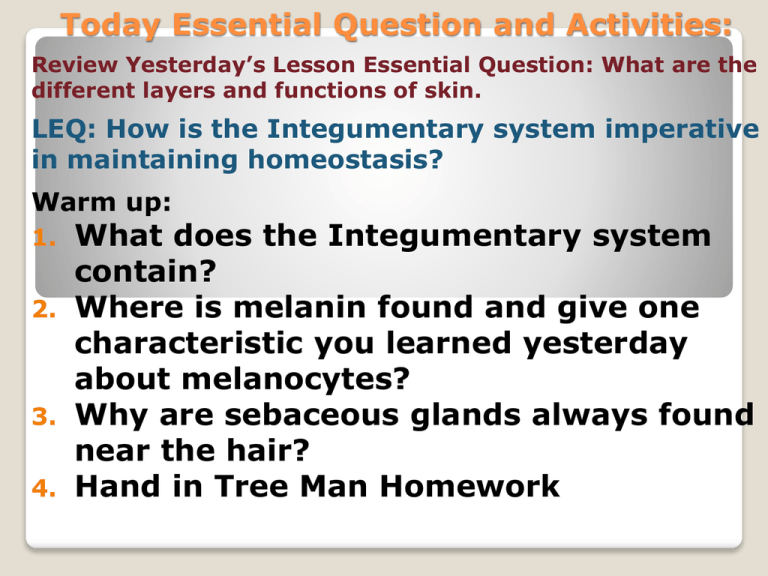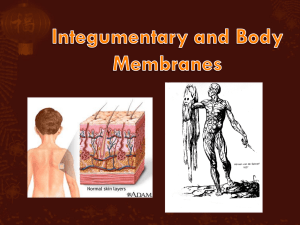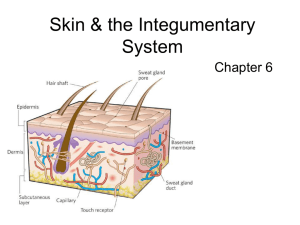Integumentary system - Appoquinimink High School
advertisement

Today Essential Question and Activities: Review Yesterday’s Lesson Essential Question: What are the different layers and functions of skin. LEQ: How is the Integumentary system imperative in maintaining homeostasis? Warm up: What does the Integumentary system contain? 2. Where is melanin found and give one characteristic you learned yesterday about melanocytes? 3. Why are sebaceous glands always found near the hair? 4. Hand in Tree Man Homework 1. Today Essential Question and Activities: LEQ: How is the Integumentary system imperative in maintaining homeostasis? ACTIVITIES: Graphic Organizer, Build the Skin, Lost in the desert. 1. Complete the Graphic organizer. Once finished bring it up to me to be checked off. 2. When your partner is done too- make a list of the supplies for the lab and for each supply come up with an educated guess about what part of the skin it could correlate to and WHY. 3. Have me check that off when finished and I will give you the lab instructions and materials. 4. Once you have constructed your skin bring it up to show me, finish ALL questions and hand in. Integumentary system The skin and accessory organs (Hair, membranes, glands, etc) Membranes Serous membranes: Line body cavities that lack openings to the outside. is a smooth membrane consisting of a thin layer of epidermal cells They line and enclose several body cavities, where they secrete a lubricating fluid which reduces friction from muscle movement. Membranes Serous membranes: Basically they cover areas such as the thoracic cavity the heart and lungs area, and ventral cavity. Membranes Serous membranes: Membranes Mucous membranes:are involved in absorption and secretion. They line various body cavities that are exposed to the external environment and internal organs. Examples are the nasal and oral cavities, tubes of the respiratory, digestive and reproductive tracts. Membranes Mucous membranes: Usually found near or on glands that will help secrete a mucous. It is at several places continuous with skin. Why would you find mucous membranes continuous or near or connected to your skin? Membranes Membranes Synovial membranes: is the soft tissue that lines the noncartilaginous surfaces within joints (synovial joints). They secrete a fluid to lubricate the joints. Synovial Membranes membranes: Membranes Cutaneous membranes: The skin They consist of stratified squamous epithelium and the underlying connective tissues. Cutaneous membranes are thick, relatively waterproof, and dry. The skin helps in regulating body temperature and maintaining homeostasis. Membranes Cutaneous membranes: THE THREE LAYERS OF SKIN 1. EPIDERMIS 2. DERMIS 3. SUBCUTANEOUS LAYER EPIDERMIS The outer layer Composed stratified squamous epithelium of EPIDERMIS Contains five separate layers: Stratum Corneum- outer most layermostly dead cells Stratum Basale- The area where cells divide rapidly Stratum Spinosum Stratum Granulosum- only in areas where the skin is thick Stratum lucidum- only on the palms and soles. 5 Layers of Epidermis: EPIDERMIS Here is what happens to make these layers: ◦ 1. The basale layers divide rapidly pushing the cells and tissues up toward the top. ◦ 2. The closer they get to the top the less nutrients they have from the connective tissue so they eventually die (This becomes your Corneum layer) EPIDERMIS The process of these cells hardening and dying is called KERATINIZATION ◦ This is when they can secrete the protein Keratin to make the skin tough and water proof. EPIDERMIS Your epidermis also contains MELANIN: is a dark pigment that provides your skin color. ◦ Melanocytes are the cells that produce the melanin. They are found in the deep layers of the epidermis. ◦ WHY Would you want them in the deep layers instead of the corneum? EPIDERMIS HOW or why do you think people have different colors of skin then? DISCUSS with your table and come up with an answer! Most people have the same number of melanocytes but the differences are due to the amount of melanin they produce. It is genetic!! If genes instruct the melanocytes to produce a lot of melanin then your skin is darker. EPIDERMIS How do you think sunlight plays a role in melanin and skin color? (Obviously sun UVA rays can make you darker- but why do you think so?) DISCUSS as a table and come up with an answer to report out. Epidermis ANSWER: The sun stimulates (Speeds up) production of the melanin pigment. Some people depending on how dark their skin is can turn “red” or “blush” and it can be seen. What do you think is happening there to temporarily change the skin color? EPIDERMS ANSWER: When the blood vessels in the lower layers of the skin are well oxygenated the blood pigments appear bright red (hot). When the oxygen content is low, the skin can appear blueish (cold). Remember I said skin has something to do with regulating body temperaturehere is one way it doe that! EPIDERMIS DERMIS Known as the Inner layer Very thick Contains: Connective tissues, epithelial tissues, smooth muscle tissue, nervous tissue and blood vessels. This is where your fingerprints come from. Supplies nutrients to the epidermis and regulates body temperature. Contains sensory receptors (touch receptors, temperature receptors- sweat glands, and so forth) Also contains the HAIR FOLLICLES, SWEAT GLANDS, and SEBACACEOUS GLANDS DERMIS HAIR FOLLICULE: Hair is present everywhere except: palms, soles, nipples, and some external reproductive parts. Hair develops from a group of epidermal cells at the base of a hair follicule that divide and grow until they are pushed up and out and are dead. SO HAIR IS DEAD- What type DERMIS of dead cells do you think they are? DISCUSS and come up with an answer. ANSWER: Once the cells get pushed up they become the keratinized dead epidermal cells. Think back to what we talked about with Melanin and skin color. HOW do you think genetics and melanin determine hair color? DISCUSS as a group and come up with an answer. DERMIS Answer: Genes determine the type and amount of pigment the melanocyte cells will produce. So your hair follicles have melanocyte cells at the base of them. If these cells at the base of the follicle produce a lot of melanin the hair will be darker. When you get older how does your hair start to turn gray and then white? DERMIS ANSWER: The melanocyte cells eventually over time die and stop producing melanin. A person with RED hair is the exception- they have a pigment called: Trichosiderin. DERMIS Arrector Pili muscle: a smooth muscle attached to the hair follicle. Why do you think your skin would need a muscle attached to the hair? What does it do? Answer: Causes your hair to “stand up” when you have the goosbumps- either emotional response or cold. Sebaceous Glands: associated with hair follicles. Secrete oil called sebum through small ducts into the hair. Helps keep hair and skin soft and waterproof. DERMIS SWEAT GLANDS: There are different types of sweat glands. ◦ Eccrine glands: respond to a rise in temperature and are located on the forehead, neck and back where they produce droplets of sweat to cool the body down. ◦ Apocrine glands: become active at puberty or when a person is emotionally upset. (arm pit region or groin). DERMIS Sweat Gland: Sweat glands: sweat is more than just water- contains salts and other wastes. Sweat glands help regulate body temperature. DERMIS SUBCUTANEOUS LAYER Beneath the dermis Consists of Loose Connective tissue and Adipose. Contains most of the blood vessels for supplying the epidermis nutrients Also insulates- conserving body heat and keeps too much heat from coming into the body. THE THREE LAYERS: LABEL THE DIAGRAM: THE SKIN:











